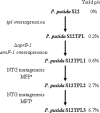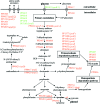Transcriptome analysis of a phenol-producing Pseudomonas putida S12 construct: genetic and physiological basis for improved production
- PMID: 17993537
- PMCID: PMC2293262
- DOI: 10.1128/JB.01379-07
Transcriptome analysis of a phenol-producing Pseudomonas putida S12 construct: genetic and physiological basis for improved production
Abstract
The unknown genetic basis for improved phenol production by a recombinant Pseudomonas putida S12 derivative bearing the tpl (tyrosine-phenol lyase) gene was investigated via comparative transcriptomics, nucleotide sequence analysis, and targeted gene disruption. We show upregulation of tyrosine biosynthetic genes and possibly decreased biosynthesis of tryptophan caused by a mutation in the trpE gene as the genetic basis for the enhanced phenol production. In addition, several genes in degradation routes connected to the tyrosine biosynthetic pathway were upregulated. This either may be a side effect that negatively affects phenol production or may point to intracellular accumulation of tyrosine or its intermediates. A number of genes identified by the transcriptome analysis were selected for targeted disruption in P. putida S12TPL3. Physiological and biochemical examination of P. putida S12TPL3 and these mutants led to the conclusion that the metabolic flux toward tyrosine in P. putida S12TPL3 was improved to such an extent that the heterologous tyrosine-phenol lyase enzyme had become the rate-limiting step in phenol biosynthesis.
Figures





Similar articles
-
Engineering of solvent-tolerant Pseudomonas putida S12 for bioproduction of phenol from glucose.Appl Environ Microbiol. 2005 Dec;71(12):8221-7. doi: 10.1128/AEM.71.12.8221-8227.2005. Appl Environ Microbiol. 2005. PMID: 16332806 Free PMC article.
-
Metabolic flux analysis of a phenol producing mutant of Pseudomonas putida S12: verification and complementation of hypotheses derived from transcriptomics.J Biotechnol. 2009 Aug 20;143(2):124-9. doi: 10.1016/j.jbiotec.2009.06.023. Epub 2009 Jun 26. J Biotechnol. 2009. PMID: 19560494
-
Redundancy in putrescine catabolism in solvent tolerant Pseudomonas putida S12.J Biotechnol. 2011 Jun 10;154(1):1-10. doi: 10.1016/j.jbiotec.2011.04.005. Epub 2011 Apr 22. J Biotechnol. 2011. PMID: 21540064
-
Research overview of L-DOPA production using a bacterial enzyme, tyrosine phenol-lyase.Proc Jpn Acad Ser B Phys Biol Sci. 2023;99(3):75-101. doi: 10.2183/pjab.99.006. Proc Jpn Acad Ser B Phys Biol Sci. 2023. PMID: 36908174 Free PMC article. Review.
-
Pseudomonas putida as a functional chassis for industrial biocatalysis: From native biochemistry to trans-metabolism.Metab Eng. 2018 Nov;50:142-155. doi: 10.1016/j.ymben.2018.05.005. Epub 2018 May 16. Metab Eng. 2018. PMID: 29758287 Review.
Cited by
-
Two-Omics Probe on the Potential of Pseudomonas sp. GDMCC 1.1703 Under Phenol Stress.Curr Microbiol. 2023 Nov 28;81(1):21. doi: 10.1007/s00284-023-03534-3. Curr Microbiol. 2023. PMID: 38012331
-
Metabolic potential of the organic-solvent tolerant Pseudomonas putida DOT-T1E deduced from its annotated genome.Microb Biotechnol. 2013 Sep;6(5):598-611. doi: 10.1111/1751-7915.12061. Epub 2013 Jul 1. Microb Biotechnol. 2013. PMID: 23815283 Free PMC article.
-
Bioproduction of p-hydroxystyrene from glucose by the solvent-tolerant bacterium Pseudomonas putida S12 in a two-phase water-decanol fermentation.Appl Environ Microbiol. 2009 Feb;75(4):931-6. doi: 10.1128/AEM.02186-08. Epub 2008 Dec 5. Appl Environ Microbiol. 2009. PMID: 19060171 Free PMC article.
-
Metabolic and regulatory rearrangements underlying efficient D-xylose utilization in engineered Pseudomonas putida S12.J Biol Chem. 2012 Apr 27;287(18):14606-14. doi: 10.1074/jbc.M111.337501. Epub 2012 Mar 13. J Biol Chem. 2012. PMID: 22416130 Free PMC article.
-
Comparative transcriptomics and proteomics of p-hydroxybenzoate producing Pseudomonas putida S12: novel responses and implications for strain improvement.Appl Microbiol Biotechnol. 2010 Jun;87(2):679-90. doi: 10.1007/s00253-010-2626-z. Epub 2010 May 7. Appl Microbiol Biotechnol. 2010. PMID: 20449741 Free PMC article.
References
-
- Arias-Barrau, E., E. R. Olivera, J. M. Luengo, C. Fernandez, B. Galan, J. L. Garcia, E. Diaz, and B. Minambres. 2004. The homogentisate pathway: a central catabolic pathway involved in the degradation of l-phenylalanine, l-tyrosine, and 3-hydroxyphenylacetate in Pseudomonas putida. J. Bacteriol. 1865062-5077. - PMC - PubMed
-
- Ballerstedt, H., R. J. M. Volkers, A. E. Mars, J. E. Hallsworth, V. A. Martins dos Santos, J. Puchalka, J. Duuren, G. Eggink, K. N. Timmis, J. A. M. de Bont, and J. Wery. 2007. Genomotyping of Pseudomonas putida strains using P. putida KT2440-based high-density DNA microarrays: implications for transcriptomics studies. Appl. Microbiol. Biotechnol. 751133-1142. - PMC - PubMed
-
- Bertani, I., M. Kojic, and V. Venturi. 2001. Regulation of the p-hydroxybenzoic acid hydroxylase gene (pobA) in plant-growth-promoting Pseudomonas putida WCS358. Microbiology 1471611-1620. - PubMed
Publication types
MeSH terms
Substances
LinkOut - more resources
Full Text Sources
Other Literature Sources

